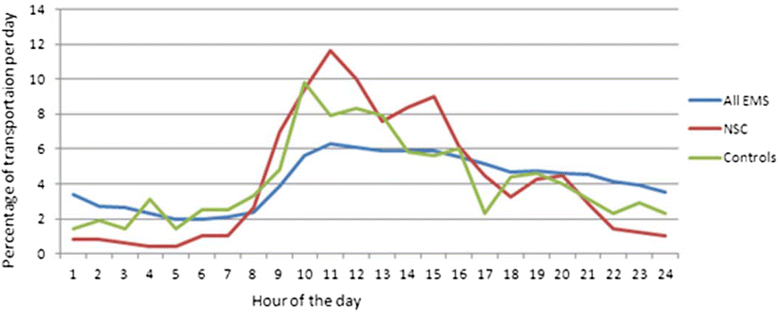Non-specific complaints in the ambulance; predisposing structural factors
- PMID: 25971395
- PMCID: PMC4437442
- DOI: 10.1186/s12873-015-0034-5
Non-specific complaints in the ambulance; predisposing structural factors
Abstract
Background: The pre-hospital assessment non-specific complaint (NSC) often applies to patients whose diagnosis does not match any other specific assessment correlating to particular symptoms or diseases, though some previous studies have found them to be related to serious underlying conditions. The aim was to identify whether the structural factors such as urgency according to the dispatch priority of the Emergency Medical Communication Centre (EMCC) or work load in the Emergency Medical Services (EMS) are predisposing factors for the assessment of NSC instead of a specific assessment.
Methods: All patients with assessed condition NSCs by the EMS to Södersjukhuset during 2011 (n = 493) were compared with gender- and age-matched controls (n = 493), which were randomly drawn from all patients with specific conditions in the EMS, regarding day of week, time of day and priority set by EMCC with chi-squared tests and multivariate logistic regression models.
Results: Among patients with NSCs, more were females (58 %) and the median age was 82. Almost all patients were categorized with NSCs during the daytime (8 a.m. to 9 p.m.), i.e. 450 (91 %) as compared to 373 (75 %) of those with specific conditions (p < 0.01). The risk of having an EMS dispatched as low priority by the EMCC was almost doubled among patients with NSCs compared to controls (OR 1.97, 95 % CI 1.38-2.79).
Conclusions: Since patients with NSCs appear most frequently during the hours with most transportations for the EMS, i.e. 10 a.m. to 2 p.m., and the risk of having the assessment NSC was doubled if the EMCC dispatched EMS as low priority, structural factors might be predisposing factors for the assessment.
Figures

Similar articles
-
Face Arm Speech Time Test use in the prehospital setting, better in the ambulance than in the emergency medical communication center.Cerebrovasc Dis. 2014;37(3):212-6. doi: 10.1159/000358116. Epub 2014 Feb 26. Cerebrovasc Dis. 2014. PMID: 24576912 Clinical Trial.
-
Preventable deaths following emergency medical dispatch--an audit study.Scand J Trauma Resusc Emerg Med. 2014 Dec 19;22:74. doi: 10.1186/s13049-014-0074-y. Scand J Trauma Resusc Emerg Med. 2014. PMID: 25524363 Free PMC article.
-
Analysis of emergency medical services triage and dispatch errors by registered nurses in Italy.J Emerg Nurs. 2014 Sep;40(5):476-83. doi: 10.1016/j.jen.2014.02.009. Epub 2014 Apr 18. J Emerg Nurs. 2014. PMID: 24746868
-
Non-urgent Emergency Callers: Characteristics and Prognosis.Prehosp Emerg Care. 2017 Mar-Apr;21(2):166-173. doi: 10.1080/10903127.2016.1218981. Epub 2016 Sep 14. Prehosp Emerg Care. 2017. PMID: 27629892
-
Reliability of a Swedish pre-hospital dispatch system in prioritizing patients.Int Emerg Nurs. 2013 Apr;21(2):143-9. doi: 10.1016/j.ienj.2011.11.006. Epub 2011 Dec 29. Int Emerg Nurs. 2013. PMID: 23615523
Cited by
-
Dispatch and prehospital transport for acute septic patients: an observational study.Scand J Trauma Resusc Emerg Med. 2017 May 12;25(1):51. doi: 10.1186/s13049-017-0393-x. Scand J Trauma Resusc Emerg Med. 2017. PMID: 28499459 Free PMC article.
-
Understanding EMS response times: a machine learning-based analysis.BMC Med Inform Decis Mak. 2025 Mar 24;25(1):143. doi: 10.1186/s12911-025-02975-z. BMC Med Inform Decis Mak. 2025. PMID: 40128718 Free PMC article.
-
Serious conditions among patients with non-specific chief complaints in the pre-hospital setting: a retrospective cohort study.Scand J Trauma Resusc Emerg Med. 2020 Jul 29;28(1):74. doi: 10.1186/s13049-020-00767-0. Scand J Trauma Resusc Emerg Med. 2020. PMID: 32727586 Free PMC article.
-
Soluble urokinase plasminogen activator receptor and lactate as prognostic biomarkers in patients presenting with non-specific chief complaints in the pre-hospital setting - the PRIUS-study.Scand J Trauma Resusc Emerg Med. 2021 Aug 12;29(1):116. doi: 10.1186/s13049-021-00908-z. Scand J Trauma Resusc Emerg Med. 2021. PMID: 34384460 Free PMC article.
-
Pre-hospital suPAR, lactate and CRP measurements for decision-making: a prospective, observational study of patients presenting non-specific complaints.Scand J Trauma Resusc Emerg Med. 2021 Oct 16;29(1):150. doi: 10.1186/s13049-021-00964-5. Scand J Trauma Resusc Emerg Med. 2021. PMID: 34656150 Free PMC article.
References
Publication types
MeSH terms
LinkOut - more resources
Full Text Sources
Other Literature Sources

